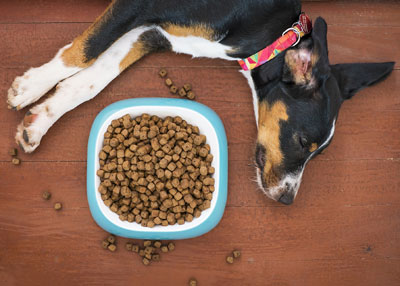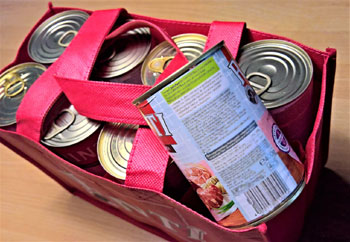The Best Food For Your Dog?
One of the most important things we can do for our pets is to feed them a good diet but that can be easier said than done. With so many options and conflicting theories, how do we know what is the best food for our pooch? Is there an easy way to tell whether we are feeding our dogs what they need?

Dog food options
The various options for feeding our dogs has never been greater. Until the invention of commercial dog food, dogs were fed table scraps and human food. The average dog's diet changed dramatically when shop bought pet food became the norm.
More recently there have been some movements back to a home cooked or home prepared dog foods plus a rise in people feeding raw food to their dogs. Much like our own diets, what dogs should be eating and what is available to owners to choose from is always changing and evolving.
So how do we, as caring dog owners wanting to have a happy and healthy dog, know what to feed our pooches for the best?
Raw feeding
BARF and other raw feeding regimes are probably one of the most contentious dog food 'trends' of our time. The raw versus cooked food debate rages on.
The idea behind raw feeding is that it is supposedly a more natural form of food for a dog as it more closely resembles what they would have eaten in the wild. In other words, it is seen by some as a more natural option than the cooked meats and ingredients in traditional commercial dog food.
While some say raw food is better for dogs, others say it is not suitable for the modern domesticated dog, it is difficult to formulate a nutritionally balanced diet at home and there is a risk of raw food contamination. However, brands exist now that will do all the hard work for you, presenting your pooch with a pre-prepared raw food meal that is ready to consume.
Commercial wet dog food
Canned and pouches of wet food have been popular for decades. Affordable, convenient, generally loved by dogs and claiming to provide the best balanced diet for your four-legged friend, their appeal is obvious.
However, even amongst the commercial dog food brands, arguments are rife regarding the best protein to carb ratio and the use of fillers and bulking agents. It is definitely important to look at the ingredients rather than price or hype. Not all commercial wet dog foods are created equal.
Dry kibble
A more recent invention which has taken off in a big way is dry dog food AKA kibble. Proponents say it is even more convenient and purse friendly than wet dog food.

Criticisms of dry dog food include lack of nutrition, potential bloat hazard and lack of flavour / interest. Those in favour say it is cheap, convenient and also better for a dog's teeth.
Price v Content
When times are tough it is understandable why we may choose dog food that is the cheapest, but this can be more costly in the long run and make your doggie feel rubbish, which we don't want.
If you do need to change your dog's food, you can research a compromise between goodness and price. That is easier than it sounds. You can use a site like All About Dog Food to help you compare the prices and ingredients of various dog foods.
You can of course look at the labels next time you are dog food shopping but websites like the above can help shed light on what all the figures mean and what exactly to look for.
What should we feed our dogs?
We could try to pit raw dog food against wet and dry foods. We could compare commercial food with home prepared meals. These are definitely things worth researching, if you really want to increase your chances of getting it right.
But for this blog let's take things back to basics. At the end of the day we want a healthy dog, so what can we look out for?
My dog loves it
One of the most common mistakes people make when deciding if their chosen dog food is a good one is the "It must be good, he loves it" response. If your child likes eating fast food, does that mean it is good? No, of course not. So take care when using your dog's enthusiasm at meal times as your barometer for whether the food you have purchased is any good.
It is a popular food
This can indicate that the food is good or it can be the result of a large marketing budget or great PR team. Just because you see a certain pet food on all the shop shelves or in expensive TV advertisements, doesn't mean it is necessarily a good dog food.

Search for reviews by people who have actually fed it to their dogs and look up the ingredients and nutritional values. You can also look into the company who is behind the food to see if you agree with their sourcing, ethos, animal testing and so on.
My dog is happy and healthy
Yes, this is more like it. This is an important part of what we should be looking for when deciding if our dog is getting what they need from their food.
From runny eyes and itchy skin to doggie smells and slimy stools, there are a number of signs we can look for which can indicate a poor diet or a food that doesn't suit our dog.
Instead of tying ourselves up in knots over brands and ratios, let's look towards our dogs for at least some of the answers.
So let's discuss some of the things we should look for when assessing whether our dogs are healthy or not.
Perfect poop
Let's start with the obvious... poop. The size, shape, colour and smell of your dog's poo will tell you a lot about their digestive health.
A good dog poo should be a nice brown colour with a medium firm consistency and a slightly bumpy form (think bowel shaped). The smell shouldn't be overly offensive and the poop shouldn't be messy to clean up i.e. there should be no nasty residue left on the ground.
A worrying poop would be one that is consistently very dark, red streaked, green and slimy or very pale (unless the dog eats a lot of bone). A very runny or soft poop or a poop like a smooth snake is also not a healthy poop.
A big voluminous poop is a no no. Healthy poop is generally smaller as the dog food isn't filled with a load of unnecessary products and fillers. And poop should not be covered in any kind of film or mucous. This can indicate inflammation of the bowel.

So next time you are scooping that poop, take an extra moment to clock its shape, volume, colour and smell. You can also get a feel for the consistency of the poop. It should be easily picked up off of the ground without leaving a mess.
And yes, smell is important. Any poop that has you grabbing a peg for your nose or gagging is a bad sign. No poop is going to smell of roses but really dreadful smelling poo is an indication of gut / food issues.
We are not talking about one rogue poop here. Occasionally a poop can come out surprisingly bad. Only take it as a sign of bad gut health if that kind of poop is the norm for your dog.
Smelly farts
Much like poop, consistetnly smelly farts would be a red flag that all is not well inside your dog's guts. Passing gas is of course a natural and totally normal thing for all of us to do including our dogs but farts that consistently smell really bad are a sign that all is not well inside.
Skin, coat and ears
Issues with skin, coat and ears are all related to a certain degree and in dogs it is often a sign of a food allergy or intolerance.
Gungy, scabby, itchy or smelly ears can be a sign of irritations, allergies and yes, digestive issues. Ears should be relatively clean with no bad smells. A healthy amount of ear wax is fine but nothing dark, sticky or smelly. Lots of things can of course cause ear issues but it is always worth taking into account.
Did you know that food allergies are actually the biggest cause of ear infections in dogs. Look for shaking of the head, rubbing of the face and even pain when ears are touched. And it is something that can happen at any stage of life. Many things can trigger an allergic reaction, even if it was something your dog has previously tolerated well for years.
A massive giveaway for digestive issues or an intolerance is a poor skin and coat condition. Itchy, flaky or inflamed skin and a dull coat, strong doggie smells and dander can all indicate potential problems. Your dog's food can be a good place to start when looking for a culprit.
Teeth
If your dog has inflamed gums or plaque on their teeth, this would point to something in their diet that is not good or wholesome. Whether it is coming from their dog food or from scraps and treats being given to the dog, it shows a level of unhealthy ingredients in their diet.
A dog being fed a good diet shouldn't have teeth issues. Sticky, gungy, discoloured teeth means your dog's diet needs to be addressed. It is also a good idea to get into a daily brushing regime. Use a soft finger toothbrush and specially made doggie toothpaste (never use human toothpaste).
Weight and build
Finally, anyone's body says a lot about what is going down the hatch and happening on the inside. Assessing a dog's weight and body shape is essential if you want to keep your dog in peak condition.
A big mistake many dog owners make when trying to assess their dog's weight is looking at them from the side. You can tell a little from that position, for example a rotund belly. However, viewing your dog by looking down from above will give you much more information about your dog's waistline.
With a healthy weight dog you should be able to feel the ribs if you run your hands along their sides and you should be able to see a waist when looking down at their body from above.
If your dog has no obvious waist, they are carrying a few extra pounds. If you see a waist and can feel the ribs, that is perfect. If you can visually see the ribs and the spine, they are possibly under weight.
You see your dog every day so it can be harder to spot changes or assess your dog critically. If you struggle to be objective, ask a friend to do the above assessment for you.

What has all this got to do with dog food? Well, think about the foods we humans eat and how they ultimately make us look and feel. Similarly, a dog food that is providing a good balanced diet with all the nutrients your dog needs should not be causing your dog weight issues, unless you are over or under feeding. Check calories and protein vs carb content. Also check the recommended feeding portions but do bear in mind that the manufacturer often overstates meal sizes. Experiment and use the brand recommendations as a starting guideline only.
That's it folks. Here's to more informed dog food choices and healthy, happy dogs.
By Jenny Prevel
© D for Dog www.dfordog.co.uk
This article belongs strictly to D for Dog and we do not authorise the copying of all or any part of it.
